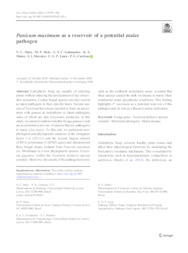Panicum maximum as a reservoir of a potential maize pathogen.
Panicum maximum as a reservoir of a potential maize pathogen.
Author(s): MAIA, N. C.; MELO, M. P.; GUIMARÃES, S. S. C.; MATOS, K. S.; MOREIRA, S. I.; LANA, U. G. de P.; CARDOSO, P. G.
Summary: Endophytic fungi are capable of infecting plants without inducing the development of any observable symptoms. Certain fungal species can also coexist as latent pathogens in their specific hosts. Several species of Fusarium have been reported to form an association with grasses as endophytes or latent pathogens, some of which are also mycotoxin producers. In this study, we aimed to address whether forage grasses could act as potential reservoirs of species that are pathogenic to maize (Zea mays). To this end, we performed morphological and phylogenetic analyses of the elongation factor 1-α (EF-1α) and the second largest subunit of RNA polymerase II (RPB2) genes and characterized three fungal strains isolated from Panicum maximum (cv. Mombaça) as a new phylogenetic species, Fusarium gigantea, within the Fusarium fujikuroi species complex. Moreover, the results of the pathogenicity test such as the toothpick inoculation assay, revealed that these species caused the stalk rot disease in maize when maintained under greenhouse conditions. This finding highlights P. maximum as a potential reservoir of this pathogen and its role as a threat to maize cultivation.
Publication year: 2021
Types of publication: Journal article
Unit: Embrapa Maize & Sorghum
Keywords: Doença de Planta, Filogenia molecular, Milho, Patógeno, Planta Forrageira
Observation
Some of Embrapa's publications are published as ePub files. To read them, use or download one of the following free software options to your computer or mobile device. Android: Google Play Books; IOS: iBooks; Windows and Linux: Calibre.
Access other publications
Access the Agricultural Research Database (BDPA) to consult Embrapa's full library collection and records.
Visit Embrapa Bookstore to purchase books and other publications sold by Embrapa.

